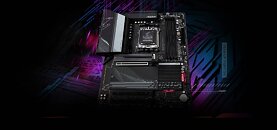- Joined
- Oct 9, 2007
- Messages
- 47,670 (7.43/day)
- Location
- Dublin, Ireland
| System Name | RBMK-1000 |
|---|---|
| Processor | AMD Ryzen 7 5700G |
| Motherboard | Gigabyte B550 AORUS Elite V2 |
| Cooling | DeepCool Gammax L240 V2 |
| Memory | 2x 16GB DDR4-3200 |
| Video Card(s) | Galax RTX 4070 Ti EX |
| Storage | Samsung 990 1TB |
| Display(s) | BenQ 1440p 60 Hz 27-inch |
| Case | Corsair Carbide 100R |
| Audio Device(s) | ASUS SupremeFX S1220A |
| Power Supply | Cooler Master MWE Gold 650W |
| Mouse | ASUS ROG Strix Impact |
| Keyboard | Gamdias Hermes E2 |
| Software | Windows 11 Pro |
In the first week of the 2025 International CES, Intel and AMD are expected to expand their desktop processor product stacks, with the introduction of 65 W models; and with them, more affordable motherboard chipset models. AMD is expected to launch the AMD B850 and AMD B840; while Intel debuts the Intel B860 and H810. Board Channels, a site that tracks hardware launches at the retail channel level, says that AMD is expected to set January 15 as the market availability date for motherboards based on the AMD B850 and B840. The chipset will be announced at AMD's January 7th event.
Meanwhile, Intel is expected to announce its mid-range Intel B860 and entry-level Intel H810 on its own event slated for January 7, but with product availability on January 13. The AMD B850 is essentially a rebadged B650, but motherboard vendors can optionally enable Gen 5 PEG instead of Gen 4, at which point the platform would essentially be an AMD X870, but without the mandatory discrete USB4 host controller. The AMD B850 supports CPU overclocking. The AMD B840 lacks this, and is functionally similar to the AMD B550 chipset from the Socket AM4 platform, except that it lacks CPU overclocking support. Meanwhile, the Intel B860 is expected to feature a similar I/O as the Intel B760 from the Socket LGA1700 platform. The H810 is expected to be a lean entry-level option. Both the Intel B860 and H810 are expected to lack CPU overclocking support, but the B860 probably retains memory overclocking capability.

View at TechPowerUp Main Site | Source
Meanwhile, Intel is expected to announce its mid-range Intel B860 and entry-level Intel H810 on its own event slated for January 7, but with product availability on January 13. The AMD B850 is essentially a rebadged B650, but motherboard vendors can optionally enable Gen 5 PEG instead of Gen 4, at which point the platform would essentially be an AMD X870, but without the mandatory discrete USB4 host controller. The AMD B850 supports CPU overclocking. The AMD B840 lacks this, and is functionally similar to the AMD B550 chipset from the Socket AM4 platform, except that it lacks CPU overclocking support. Meanwhile, the Intel B860 is expected to feature a similar I/O as the Intel B760 from the Socket LGA1700 platform. The H810 is expected to be a lean entry-level option. Both the Intel B860 and H810 are expected to lack CPU overclocking support, but the B860 probably retains memory overclocking capability.

View at TechPowerUp Main Site | Source




